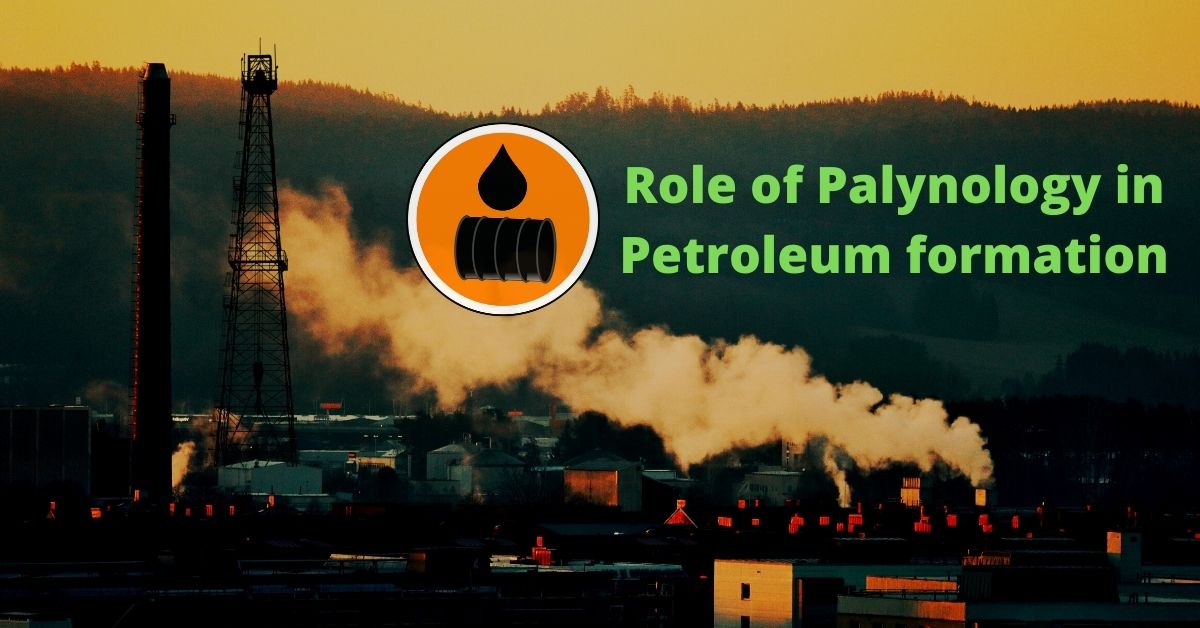Petroleum is the general term for all the natural hydrocarbons found in rocks. It consists of an extremely complex mixture of a large number of different hydrocarbons generally accompanied by small quantities of related compounds containing Nitrogen, Sulphur, and Oxygen. Crude oil in which these hydrocarbons predominate has a paraffin base. The oil shales do not contain petroleum as such, however, they contain pyro bituminous substances which can be altered into oil and bitumen.
Origin
Unlike coal, petroleum retains within itself and there is no visible evidence of the nature of the material from which it was formed. All the relevant evidence points convincingly to an organic origin. Such as:
- Optical activity;
- Presence of porphyrin;
- The presence of hydrocarbons is closely similar to those present in marine plants and animals;
- Demonstration of the early stages of oil formation in the Gulf of Mexico and Black sea;
- Oil is not formed in association with volcanoes or igneous rocks except accidentally.
Based on the above evidence, it presently originated from the organic matter of muddy sediments deposited in depressed regions of the seafloor where the water was stagnant & deficient in O2. Under such conditions, anaerobic bacteria would be expected to abstract oxygen from the organic matter, transforming it into fatty & waxy substances. The lighter members of the paraffin & other hydrocarbon series appear to be later derivatives, possibly produced by a kind of natural refining brought about by increasing pressures and temperature during deep burial together with continued bacterial activities.
Migration & concentration of petroleum
Sediments in which petroleum had its origin are called source rocks & the sediments in which oil and gas are found are termed reservoir rocks. Source beds while they contained a high proportion of seawater carrying dispersed globules of oil. Source rocks are necessarily fine-grained because only in the low depositional energy environment does organic matter get preserved. It is also necessary that a significant quantity of organic matter should be formed & transported to the depositional area without much destruction. Such a depositional environment is restricted to particular areas such as pro-deltas & inter-distributary swamps.
Reservoir rocks, on the other hand, should have primary and/or secondary porosity development. Primary porosity development requires a high energy depositional locale where the larger and better-rounded fragments are concentrated and the finer fractions of the sediment winnowed out.
Secondary porosity development is the result of post-depositional diagenetic changes and of tectonism subsequent to consolidation. As the source beds are compacted, the squeezed out fluids pass into more coarsely porous formations. After flushing into such permeable beds, the oil may migrate through them further for a long distance but when these beds remain overlain by impervious fine-grained rocks, the oil cannot again escape. The overlying impervious rocks are known as “cap rocks”. It should be noted that both source rocks and cap rocks share one important property i.e. both of them are fine-grained. However, all fine-grained rocks are good cap rocks but all are not good source rocks.
Source rock potentiality is directly dependent on the hydrocarbon content. Nevertheless, for oil to concentrate into economically exploitable deposits, the source rocks, reservoir rocks and cap rocks deposited in dissimilar palaeoenvironmental situations, must be connected up during the time of migration of oil from the source rocks. There must be a migration path or conduit between the source and reservoir.
Importance of Palynology in oil exploration
Talukdar (1982) and Manum (1983) reviewed that there are 4 main areas in oil exploration where the role of palynology is very significant:
- Stratigraphy;
- Palaeogeography reconstruction;
- Study of source rock potential;
- Study of source rock maturation.
Role of palynology in stratigraphy
Oil is formed and accumulated in sedimentary rocks. Most sedimentary basins tend to remain as negative areas over most of their aerial extent through most of the subsequent geologic time. This means that their stratigraphic details can only be obtained from the sub-surface principally by drilling wells. The volume of rock obtained as a sample from the drill core is small and that amount of sample must contain fossil remains that can be used in stratigraphic correlation. Palynology has become increasingly important in this respect of oil exploration because of the greater possibility of occurrence of microfossils in a small volume of sample than that of the megafossils.

That is why palynology has been used widely by the oil exploring organizations since 1936 when the Royal-Dutch/shell group studied the palynological succession to solve the problem of correlation of Tertiary lignites in Mexico. In India, the method was applied for the first time in 1947 by Burmah Oil Company, when they requested Prof. Sahni for establishing the palynological succession through the thick clastic sequence of Barail, Surma, Tipam and Dhekiajuli formations of Assam.
Due to the ability of the spore/pollen for wide dispersal, palynology has a definite advantage in the correlation of the non-marine sediments with the marine ones. Calcareous foraminifera occurring only in open marine conditions have also been found to be of high correlation values.
It has already been mentioned that the occurrence of oil has been found to be associated with the transition from marine to the non-marine environment of deposition because, at this transition, the maximum association between the source rocks and reservoir rocks occurs. In such situations, the correlation across interfaces of marine and non-marine facies by means of micro foraminifera is not successful. It is because of this limitation that oil companies who were pioneers in the use of forams in stratigraphy have gone in for the study of spores and pollens for this purpose. The advantages of correlation by palynology may be summarised as follows:
- The relatively resistant nature of the sporoderm;
- Relative abundance allows quantitative analysis;
- Spores and pollen grains are capable of long-distance transport enabling occurrence in a wide range of environments to facilitate the correlation of the standard marine sequences with the non-marine ones;
- Their colouration indicates the highest temperature to which the host rock was subjected subsequently to its formation;
- They indicate the ecological habitat of their source.
Role of palynology in palaeogeography reconstruction
During the time of migration of the oil and its concentration into economically exploitable deposits, the source rocks, reservoir rocks and cap rocks deposited in different palaeoenvironmental conditions must remain connected. For these reasons, in oil exploration, geologists make a lot of efforts in obtaining palaeogeographic information on the sequences in a sedimentary basin.
Land plants are sensitive indicators of the environment. The spore/pollen and other parts of such plants indicate the climate of the source area of the sediments. Remains of marine plants on the other hand are not transported to that extent as those of land plants because they occur in the depositional basin itself. Thus, the quantity of spore/pollen of shoreline land plants in a marine sedimentary deposit indicates proximity to the shoreline as does the ratio between spore/pollen of land origin to phytoplankton of marine origin. Where marine phytoplanktons are absent – the deposition was in freshwater.
The presence of marine organisms indicates the marine environment. Palaeoshoreline delineation by mapping the palynofloral density as well as the ratio between land and marine forms is very important in basin studies conducted during oil exploration. This is because, in any one geologic interval, oil accumulation is concentrated in areas on both sides of the paleo shoreline where the maximum contact between source rocks and reservoir rocks occurs.
Hoffmeister (1954, 60) utilized paleo shoreline maps prepared on the basis of spore/pollen density to demarcate areas favourable for oil occurrence in the Seminole – Oklahoma city region. Mathur and Chowdhury (1977), by this method, interpreted the details of palaeogeography and shoreline changes in the Cambay basin during the deposition of the Kalol Formation (Middle Eocene).
Role of palynology in studying source rock potential
The organic matter is incorporated in the sediments deposited and altered – at the surface by biogenic agents, and when deeply buried, in a subsiding basin by receiving sediments by thermochemical means. Photosynthetic organisms contribute the largest volume of organic matter to the source rocks of petroleum.
In the sea, the lipid-rich phytoplanktons partially digested by zooplanktons are acted on the bottom-dwellers and bacteria. Eventually, the residual components of the microalgae and bacteria are disseminated through the sediments in the form of a fine-grained amorphous film clinging to an inorganic particle that is called an amorphous sapropel.
When the concentration of amorphous sapropel is high enough, the enclosing rock is termed as source rock, because it is the material that constitutes the source material for organic hydrocarbons. By thermochemical metamorphism due to burial, the amorphous sapropel gives rise to economic deposits of combustible minerals. The insoluble organic matter remaining in a rock after extraction with solvent has been named kerogen.
Kerogen on distillation yields hydrocarbons and it is believed that kerogen is the source of petroleum. Most sedimentary kerogens are mixtures of organic matter derived from the land plants rich in the humic matter and organic matter derived from marine plants rich in lipids. Palynologists study the progressive alteration of organic material from the source area to mature source rock to understand the process of petroleum formation. This type of study is known as Taphonomy.
Palynology in studying source rock maturation
The degree of thermochemical alteration of the source material due to increasing pressure and temperature as a result of progressive burial is known as maturation. Here also palynology has provided us with the tool for estimating the degree of maturation of the source rock. The degree of metamorphism of source rocks is best determined by studying the colourations of fossil spores and pollens and the vitrinite reflectance of plant remains. The latter study also yields other structural and stratigraphic information on a sequence which is of immense importance in oil exploration.
If you have any query regarding this post, then don’t hesitate to comment below. Thank you.
What is Sapropel?
The residual components of the microalgae and bacteria are disseminated through the sediments in the form of a fine-grained amorphous film clinging to an inorganic particle that is called an amorphous sapropel.
What is Kerogen?
By thermochemical metamorphism due to burial, the amorphous sapropel gives rise to economic deposits of combustible minerals. The insoluble organic matter remaining in a rock after extraction with solvent has been named kerogen.

